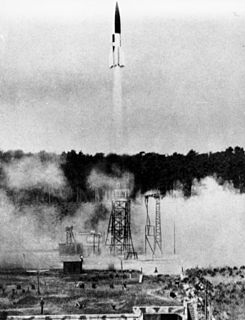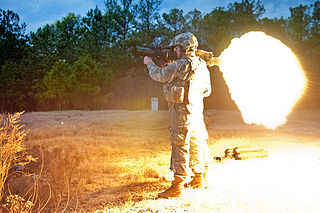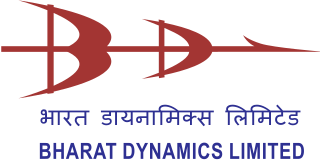
The AIM-120 Advanced Medium-Range Air-to-Air Missile, or AMRAAM, is an American beyond-visual-range air-to-air missile (BVRAAM) capable of all-weather day-and-night operations. Designed with a 7-inch (180mm) diameter form-and-fit factor, and employing active transmit-receive radar guidance instead of semi-active receive-only radar guidance, it has the advantage of being a fire-and-forget weapon when compared to the previous generation Sparrow missiles. When an AMRAAM missile is launched, NATO pilots use the brevity code Fox Three.

In modern language, a missile, also known as a guided missile or guided rocket, is a guided airborne ranged weapon capable of self-propelled flight usually by a jet engine or rocket motor. Missiles have four system components: targeting/guidance system, flight system, engine and warhead. Missiles come in types adapted for different purposes: surface-to-surface and air-to-surface missiles, surface-to-air missiles, air-to-air missiles, and anti-satellite weapons.

The MIM-104 Patriot is a surface-to-air missile (SAM) system, the primary of its kind used by the United States Army and several allied nations. It is manufactured by the U.S. defense contractor Raytheon and derives its name from the radar component of the weapon system. The AN/MPQ-53 at the heart of the system is known as the "Phased Array Tracking Radar to Intercept on Target" which is a backronym for PATRIOT. The Patriot System replaced the Nike Hercules system as the U.S. Army's primary High to Medium Air Defense (HIMAD) system, and replaced the MIM-23 Hawk system as the U.S. Army's medium tactical air defense system. In addition to these roles, Patriot has been given the function of the U.S. Army's anti-ballistic missile (ABM) system, which is now Patriot's primary mission. The system is expected to stay fielded until at least 2040.

An anti-ship missile (AShM) is a guided missile that is designed for use against ships and large boats. Most anti-ship missiles are of the sea skimming variety, and many use a combination of inertial guidance and active radar homing. A good number of other anti-ship missiles use infrared homing to follow the heat that is emitted by a ship; it is also possible for anti-ship missiles to be guided by radio command all the way.

The Boeing YAL-1 Airborne Laser Testbed weapons system was a megawatt-class chemical oxygen iodine laser (COIL) mounted inside a modified military aircraft same as the Boeing 747-400F. It was primarily designed as a missile defense system to destroy tactical ballistic missiles (TBMs) while in boost phase. The aircraft was designated YAL-1A in 2004 by the U.S. Department of Defense.

A surface-to-air missile (SAM), also known as a ground-to-air missile (GTAM) or surface-to-air guided weapon (SAGW), is a missile designed to be launched from the ground to destroy aircraft or other missiles. It is one type of anti-aircraft system; in modern armed forces, missiles have replaced most other forms of dedicated anti-aircraft weapons, with anti-aircraft guns pushed into specialized roles.

An air-to-air missile (AAM) is a missile fired from an aircraft for the purpose of destroying another aircraft. AAMs are typically powered by one or more rocket motors, usually solid fueled but sometimes liquid fueled. Ramjet engines, as used on the Meteor (missile), are emerging as propulsion that will enable future medium-range missiles to maintain higher average speed across their engagement envelope.

The Exocet is a French-built anti-ship missile whose various versions can be launched from surface vessels, submarines, helicopters and fixed-wing aircraft. The Exocet saw its first wartime launch during the Falklands War.

A shoulder-fired missile, shoulder-launched missile, man-portable rocket launcher, or man-portable missile is an explosive-carrying, self-propelled projectile fired at a target, while being small enough to be carried by a single person and fired while held on one's shoulder. The word "missile" in this context is used in its original broad sense which encompasses all guided missiles and unguided rockets. In many instances, although not technically defining all shoulder-fired missiles, the name bazooka is used as an informal name regularly, although the actual Bazooka is a type of shoulder-fired unguided rocket launcher in its own right.

The MBDA MICA is an anti-air multi-target, all weather, fire-and-forget short and medium-range missile system. It is intended for use both by air platforms as individual missiles as well as ground units and ships, which can be equipped with the rapid fire MICA Vertical Launch System. It is fitted with a thrust vector control (TVC) system. It was developed from 1982 onward by Matra. The first trials occurred in 1991, and the missile was commissioned in 1996 to equip the Rafale and Mirage 2000. It is a replacement for both the Super 530 in the interception role and the Magic II in the dogfighting role.

Fireflash was the United Kingdom's first air-to-air guided missile to see service with the Royal Air Force. Constructed by Fairey Aviation, the missile utilised radar beam riding guidance. Fireflash had relatively limited performance and required the launching aircraft to approach the target from a limited angle astern.

An anti-radiation missile (ARM) is a missile designed to detect and home in on an enemy radio emission source. Typically, these are designed for use against an enemy radar, although jammers and even radios used for communications can also be targeted in this manner.

A United States Department of Defense aerospace vehicle designation is determined by a detailed protocol which identifies all aircraft, helicopters, rockets, missiles, spacecraft, and other aerial vehicles in military use by the United States Armed Forces.

The AGM-86 ALCM is an American subsonic air-launched cruise missile (ALCM) built by Boeing and operated by the United States Air Force. This missile was developed to increase the effectiveness and survivability of the Boeing B-52H Stratofortress strategic bomber. The missile dilutes an enemy's forces and complicates air defense of its territory.
Anti-surface warfare is the branch of naval warfare concerned with the suppression of surface combatants. More generally, it is any weapons, sensors, or operations intended to attack or limit the effectiveness of an adversary's surface ships. Before the adoption of the submarine and naval aviation, all naval warfare consisted of anti-surface warfare. The distinct concept of an anti-surface warfare capability emerged after World War II, and literature on the subject as a distinct discipline is inherently dominated by the dynamics of the Cold War.
Saturation attack is a military tactic in which the attacking side hopes to gain an advantage by overwhelming the defending side's technological, physical and mental ability to respond effectively. During the Cold War and after, the conventional saturation missile attack against naval and land targets was and is a much feared eventuality.

Bharat Dynamics Limited (BDL) is one of India's manufacturers of ammunitions and missile systems. It was founded in 1970 in Hyderabad, Telangana, India. BDL was established in the year 1970 to be a manufacturing base for guided weapon systems. Begun with a pool of engineers drawn from Indian Ordnance Factories, DRDO and aerospace industries, BDL began by producing a first generation anti-tank guided missile - the French SS11B1. This product was a culmination of a licence agreement the Government of India entered into with Aerospatiale. BDL has three manufacturing units, located at Kanchanbagh, Hyderabad, Telangana; Bhanur, Medak district, Telangana and Visakhapatnam, Andhra Pradesh.

The Delilah missile is a cruise missile or loitering munition developed in Israel by Israel Military Industries (IMI). It is designed to target moving and re-locatable targets with a circular error probable (CEP) of 1 metre. Unlike a typical cruise missile, which is locked onto a pre-programmed target prior to launch, the Delilah missile's unique feature, as claimed by the manufacturer, is being able to loiter and surveil an area before a remote weapon systems officer, usually from the launching fighter aircraft, identifies the specific target of the attack.
Operation Iron Hand was a joint United States Air Force (USAF) and United States Navy (USN) operation conducted from 1965 to 1973 during the Vietnam War. It was a type of Suppression of Enemy Air Defenses (SEAD) mission, primarily intended to suppress Soviet-supplied surface-to-air missile (SAM) systems in North Vietnam, although neutralizing radar-directed anti-aircraft artillery (AAA) was important as well. "Iron Hand" refers both to the development of the tactics and equipment, and the numerous individual "Iron Hand missions" that generally accompanied strike packages of the USAF and USN. The "Iron Hand" is a metaphor to the steady hand and nerves of steel it took for pilots to fly directly at the radar-emitting anti-aircraft missile sites while the radar-seeking missiles flew down to destroy the target. The tactics employed on the Iron Hand missions were primarily designed to diminish the threat of SA-2 missiles to a bombing strike force.

The Henschel Hs 298 was a 1940s German rocket-powered air-to-air missile designed by Professor Herbert Wagner of Henschel.
















